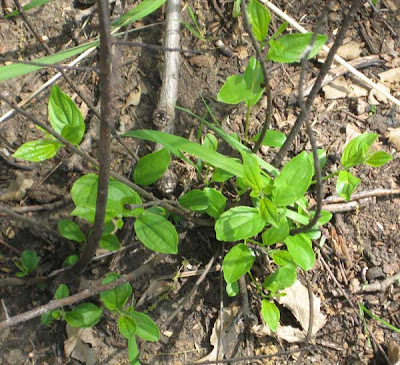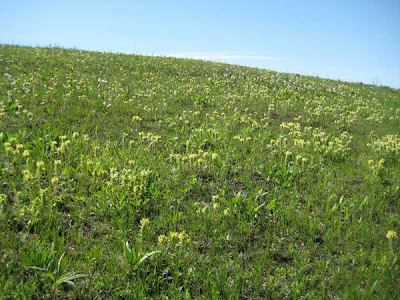
We are in the midst of our major push on bramble control in our savanna areas. Because of our great spring burns, all the brambles were top killed but immediately begin to form new shoots. Most of these new shoots are from the bases of the old canes, although some arise from dormant shoots in the underground root systems. The date of the burn at each location essentially resets the clock. Thus, the brambles of areas burned earliest will be ready to deal with first. As in past years, we are spraying the resprouts with Garlon 3A, which works well.
In order to ensure we don't miss any areas, I set up a detailed database using GPS. After all our burns were finished, I walked all the savanna areas, looking for major bramble patches. These were easy to spot, as the reddish canes can be seen from a distance. Each patch got a unique ID number and a GPS waypoint, as well as the bramble species (blackberry, red raspberry, black raspberry), the management unit, and notes on the extent of the patch. The data were mapped in ArcGIS and were also transferred to an Excel spreadsheet. In the spreadsheet I also had a field with a priority rating (1 through 6, with 6 being the largest). I ended up with 54 bramble patches, some relatively small and others quite large.
Once all this was finished, I monitored the patches, looking for evidence that they had started to resprout. I expected those burned earliest to resprout first, and this was indeed the case. As soon as a patch had sprayable resprouts, we started treatment. At first this only involved Kathie and I, but soon Marci, Susan, and Heisley also participated. This past week, as things became critical, we all even worked on Sunday.
The photo above shows us working in Unit 12A (which we called the White Oak Savanna), where there was a fairly large bramble patch mixed in with hazelnut. The dead canes are visible.
Spraying resprouts is fairly detailed work, as these savanna areas have lots of good species above ground, so it is essential to keep the herbicide confined. (Already showing in this unit are extensive shooting star patches, as well as scattered clumps of cream gentian, Culver's root, lion's foot, etc. etc.)
Over the past week or so we have made great progress, although we still have many patches that have not been sprayed. So far we have concentrated on the larger clones. If time permits we will work on the smaller ones.
Also, a single pass through these areas is not enough. The sprouts do not all develop simultaneously. Thus, we plan to return to these areas in a couple of weeks and spray any new sprouts (or those missed in the first pass). This is the second year of what will unfortunately be a long battle.
However, we have had good success in earlier years. Last year, with partial support from a LIP grant from the Wisconsin DNR, we brought under control the brambles in several major areas of our ridge-top bur oak savannas. Hopefully, we will eventually suppress bramble growth in all of the savannas.
Those whose experience is only with prairie restoration might wonder whether we are not being paranoid about brambles. However, brambles are much more of a problem in savannas than in prairies, especially savannas that have been restored. Once an area is opened up by clearing it of all the invasive trees and brush, brambles flourish. Research has shown that the bramble seed bank is very long lived, and with increased sunlight bramble growth begins. The first few years the infestation may not be too bad, but eventually it gets out of hand. All burning does is top-kill the plants.
One reason why it is essential to burn oak savannas every year is to help check bramble growth. A year or two without a burn and the brambles dominate, making it difficult to carry a fire. Prairies might be burned on a two- or three-year cycle, but if possible savannas should be burned every year.













